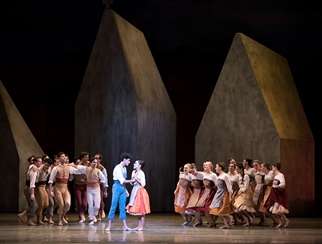|
Back
A Kiss But Never Goodbye Miami
Adrienne Arsht Center for the Performing Arts
02/10/2017 - & February 11, 12* (Miami), 24, 25, 26 (Palm Beach), March 11, 12 (Fort Lauderdale), 2017
Walpurgisnacht Ballet
George Balanchine (Choreography), Charles Gounod (Music)
Polyphonia
Christopher Wheeldon (Choreography), György Ligeti (Music)
The Fairy’s Kiss
Alexei Ratmansky (Choreography), Igor Stravinsky (Music)
Jeanette Delgado, Renan Cerdeiro, Renato Penteado, Simone Messmer, Ashley Knox, Emily Bromberg, Nicole Stalker, Maya Collins, Callie Manning, Jordan-Elizabeth Long, Adriana Pierce, Lauren Fadeley, Helen Ruiz, Jennifer Lauren, Amir Yogev, Chase Swatosh, Didier Bramaz, Michael Sean Breeden, and members of Miami City Ballet corps de ballet
Francisco Rennó (pianist), Opus One Orchestra, Gary Sheldon (conductor)
Jérôme Kaplan (scenic design), Karinska, Holly Hynes, Jérôme Kaplan (costume design), John Hall, Mark Stanley, James Ingalls (lighting design), Wendall Harrington (projection design)

The Fairy’s Kiss: R. Cerdeiro, J. Delgado (© Gene Schiavone)
Miami City Ballet’s third program this season was especially ambitious: a work that is new to the rep, followed by a much needed revival of a recent premiere and a world premiere by one of today’s most successful choreographers.
The premiere is the place to start since it is what has caused so much commotion in the press. With a world premiere there is always the hope of a hit. The Fairy’s Kiss is a theme that Alexei Ratmansky is attempting for the third time. The choreography is inventive and with Renan Cerdeiro as the Young Man, Jeanette Delgado as his fiancée and Simone Messmer as the Fairy, the roles could not be better performed. The designs of Jérôme Kaplan (sets and costumes), James Ingalls (lighting) and Wendall Harrington (projection) are attractive and properly mood enhancing. Stravinsky’s score which took a Tchaikovsky song (which inspired None But the Lonely Heart) is a marvel of beauty and imagination. The problem with The Fairy’s Kiss is that the libretto is simply not interesting. We might be stunned by Cerdeiro’s leaps of airborne perseverance and Messmer’s intensity as the villainess, but there are no compelling characters. And though short (probably 40 minutes), there are some obvious longueurs; by the end, it is almost a parody on tradition. A new story ballet would have been refreshing in this age of technology with its lack of humanity, but this is not a work that will be performed often at Miami City Ballet. The resources required must have been enormous, likewise the anticipation. There is much to admire about The Fairy’s Kiss, yet it evaporates almost before the curtain calls end. Regardless ballet lovers eagerly await Ratmansky’s next venture into other worlds.
The program got off to a thrilling start with its first production of Balanchine’s Walpurgisnacht Ballet surrounded by Gounod’s familiar music written for his opera Faust. But even when Faust is offered today, it is usually minus the ballet, or at best in a much reduced version. Though Balanchine suggests the play of the spirits during a May Night celebration, this is a pure dance piece; trying to find a text would remove the soul. Jeanette Delgado’s command of the delicately intricate footwork with her beaming smile while partnered with the masculine and debonair Renato Penteado grips an audience eager to be stunned. This continues with the elegance of Ashley Knox as she made the most of her light and tender movements, all those steps. The corps presents a solid framework when it, along with the lead women, literally let their hair down and deliver the wallop that we have anticipated since the beginning. This is Balanchine and Miami City Ballet at their best. Walpurgisnacht Ballet will take its place among this company’s most popular works.
Christopher Wheeldon’s Polyphonia, set to piano pieces of György Ligeti, provides the essence of this piece. On initially viewing this ballet, I remember being thrilled but almost overwhelmed with the amount of material to be digested. This time it felt easier to take in and with dancers as intense and secure as Helen Ruiz, Didier Bramaz, Lauren Fadelely and Chase Swatosh, a performance standard has been set. Ruiz was the breakout here. When she gets her moment in the spotlight, the magnetism she generates is breathtaking. Polyphonia might not seem like the sort of piece that would create such a resonance with Miami’s audience (which is so grounded in the classical) but no one present could deny that this is where the company shows its greatest assets. It is interesting how Wheeldon found such melody from a composer we could hardly define as lyrical. The dancers must feel such security when guided by a pianist at the level of Francisco Rennó. Not enough can ever be said about the brilliance of Opus One Orchestra under the leadership of Gary Sheldon. Someday it would be a privilege to hear just these quietly adept musicians, on their own, in concert. This program will be repeated at the Kravis Center for the Performing Arts in Palm Beach February 24 through 26 and at the Broward Center for the Performing Arts in Fort Lauderdale March 11 and 12.
Jeff Haller
|